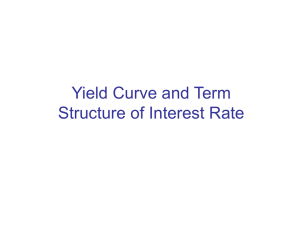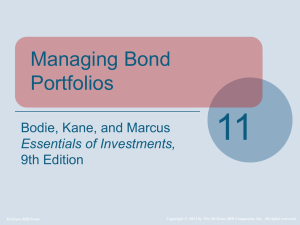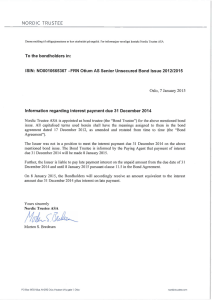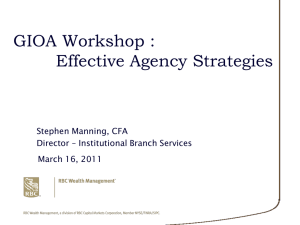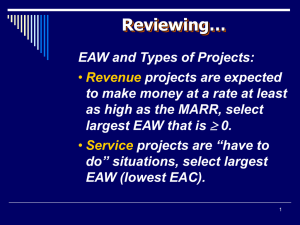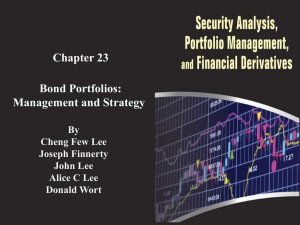The price level
advertisement
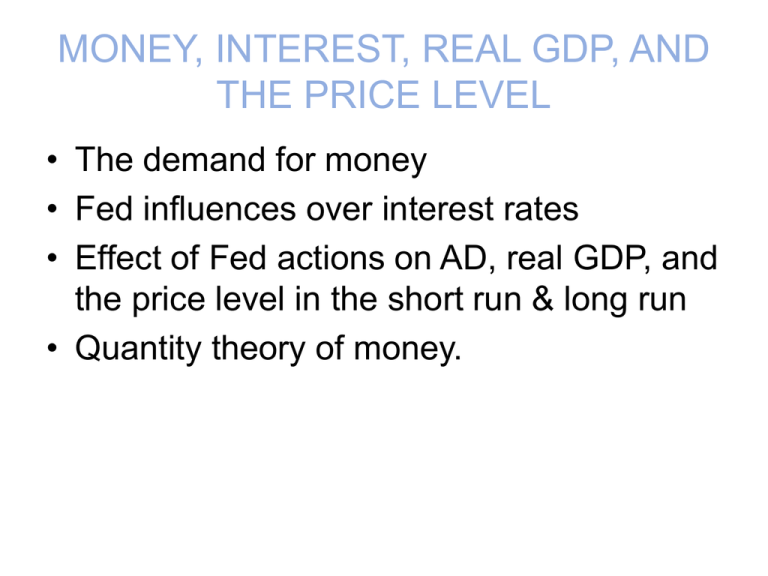
MONEY, INTEREST, REAL GDP, AND THE PRICE LEVEL • The demand for money • Fed influences over interest rates • Effect of Fed actions on AD, real GDP, and the price level in the short run & long run • Quantity theory of money. The Demand for Money • The Determinants of Money Demand – The quantity of money that people plan to hold depends on four main factors – The price level – The interest rate – Real incomes (Real GDP) – Financial innovation The Demand for Money • The price level – A rise in the price level • increases the nominal quantity of money demanded • doesn’t change the real quantity of money that people plan to hold. – The quantity of nominal money demanded is proportional to the price level • a 10 percent rise in the price level increases the quantity of nominal money demanded by 10 percent. The Demand for Money • The interest rate – the opportunity cost of holding wealth in the form of money rather than an interest-bearing asset. – A rise in the interest rate decreases the quantity of money that people plan to hold. • Real GDP – An increase in real GDP increases the volume of expenditure, which increases the quantity of real money that people plan to hold. The Demand for Money • Financial innovation – That lowers the cost of switching between money and interest-bearing assets decreases the quantity of money that people plan to hold. The Demand for Money • The Demand for Money Curve – Shows the relationship between the quantity of real money demanded (M/P) and the interest rate when all other influences on the amount of money that people wish to hold remain the same. The Demand for Money – The demand for money curve slopes downward The Demand for Money • Shifts in the Demand for Money Curve – Real GDP – Financial innovation Interest Rate Determination – An interest rate is the percentage yield on a financial security such as a bond or a loan. – The price of a bond and the interest rate are inversely related. – If the price of a bond falls, the interest rate on the bond rises. – If the price of a bond rises, the interest rate on the bond falls. The Bond Market. • Bond features • Maturity date is the specific future date on which the maturity value will be paid to the bond holder. – Bond maturity dates when issued generally range from 3 months up to 30 years. • Coupon rate – Between the date of issuance and the maturity date, annual interest payment equals the coupon rate times the maturity value. The Bond Market. • Yield to maturity • the effective interest rate that the bond-holder earns if the bond is held to maturity. • Bond price • If P=maturity value, bond sells at “par”. • If P>maturity value, bond sells above “par”. • Example: – Bond that matures 20 years from today with a maturity value of $1000 and a coupon rate of 10% will pay: – $100 per year for 20 years – $1000 at maturity – The bond could be sold at any point in time for a price above or below its maturity value. The Bond Market. • Computing yields on one year bonds • coupon rate = cr, maturity value =mv, price = P • Yield = (MV+cr(MV))/P -1 = MV(1+cr)/P -1 – As P rises, yield (interest rate) falls. – If P=MV (par), yield=cr – If P>MV (above par), yield<cr • What is the yield on a one year bond that has a maturity value of 1000 and coupon rate of 8% if price equals – $900 $950 $1050 The Bond Market. • Computing yields on Zero Coupon Bonds. • No interest payments are made between the sale of the bond and its maturity. • yield = (MV/P)1/T – 1 • If you buy a zero coupon bond today for $1000 and it has a maturity value of $1500 in 10 years – yield = (1500/1000)1/10 -1 = .0414 = 4.14% • As the price paid for a bond increases, the yield (interest rate) falls. The Bond Market. • Determinants of bond yields – Risk • Debt rating agencies: » Moody’s & Standard and Poors » AAA=superior quality » C=imminent default • Inflation risk. – Term • Longer term bonds have greater inflation and default risk. The Bond Market. • Yield curve – Shows relationship between yield and term on government bonds – Slope of yield curve reflects • Expectations of future short term interest rates • Greater risk of long term bonds – If short term interest rates are expected to be constant in the future, yield curve will slope upward reflecting risk premia for longer term bonds. – A steepening of the yield curve suggests that financial markets believe short term interest rates will be rising in the future. • The dynamic yield curve • The bond market Interest Rate Determination • Money Market Equilibrium – The Fed determines the quantity of money supplied and on any given day, that quantity is fixed. – The supply of money curve is vertical at the given quantity of money supplied. – Money market equilibrium determines the interest rate. Interest Rate Determination Interest Rate Determination – If the Fed increases the money supply, interest rates will fall. – As money supply increases, banks have more loanable funds, interest rates are reduced. – Fed has better control over short term than long Short-Run Effects of Money on Real GDP, and the Price Level • Ripple Effects of Monetary Policy – If the Fed increases the interest rate, three events follow: 1. Investment and consumption expenditures decrease. 2. The value of the $ rises and net exports decrease. 3. A multiplier process unfolds. Short-Run Effects of Money on Real GDP, and the Price Level – The Fed tightens the money supply to reduce inflationary pressure. Real GDP decreases and the price level falls. Short-Run Effects of Money on Real GDP, and the Price Level – Effects of an Increase in the money supply to recover from recession. Short-Run Effects of Money on Real GDP, and the Price Level • Limitations of Monetary Stabilization Policy – The impact depends on the sensitivity of expenditure plans to the interest rate. – The effects of monetary policy can take a long time be realized. – These effects are variable and hard to predict. LR Effects of Money on Real GDP and the Price Level • An increase in the money supply will increase AD. • SR Effects: – Real wage falls – Unemployment falls – Real GDP increases. – Price level rises. LR Effects of Money on Real GDP and the Price Level • Movement to new LR equilibrium – the money wage rate rises – SAS decreases. – RGDP decreases – P rises • Compared to original LR equil. – No change in RGDP, unempl, real wage – Higher prices, nominal GDP & nominal wage Quantity Theory of Money – Equation of exchange – MV = Py – M=money supply – V=velocity of money – P=price level – y=real GDP Quantity Theory of Money – MV = PY – Q-theory assumes that velocity and potential GDP are not affected by the quantity of money. – P = (MV/Y) – Because (V/Y) does not change when M changes, a change in M brings a proportionate change in P. Quantity Theory of Money Quantity Theory of Money – P = (V/Y)M – Divide this equation by – P = (V/Y)M – and the term (V/Y) cancels to give – P/P = M/M – P/P is the inflation rate – M/M is the growth rate of the quantity of money. Quantity Theory of Money • Historical Evidence on the Quantity Theory of Money – U.S. money growth and inflation are correlated – more so in the long run than the short run – broadly consistent with the quantity theory. Quantity Theory of Money Quantity Theory of Money Decade averages show stronger relationship Quantity Theory of Money • International Evidence



